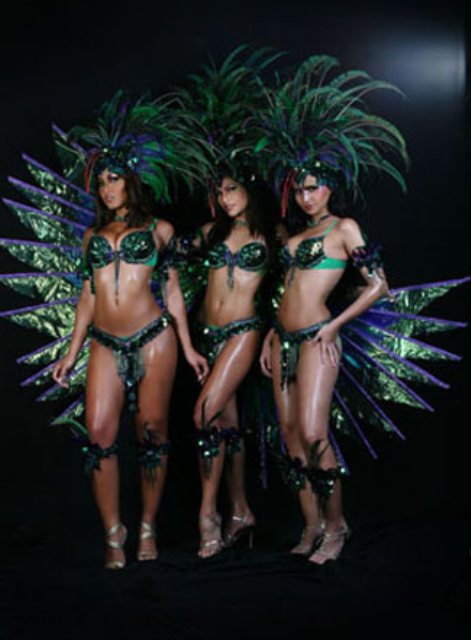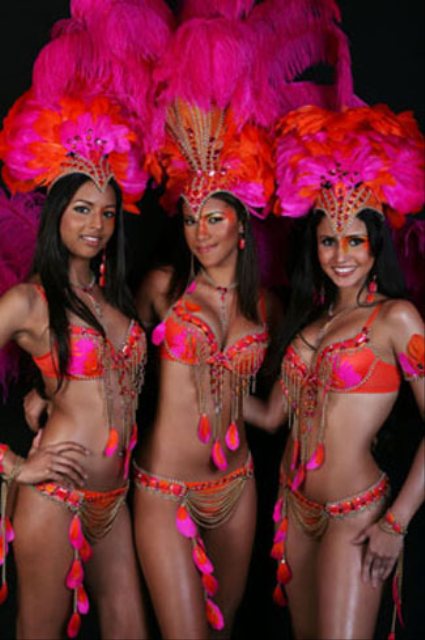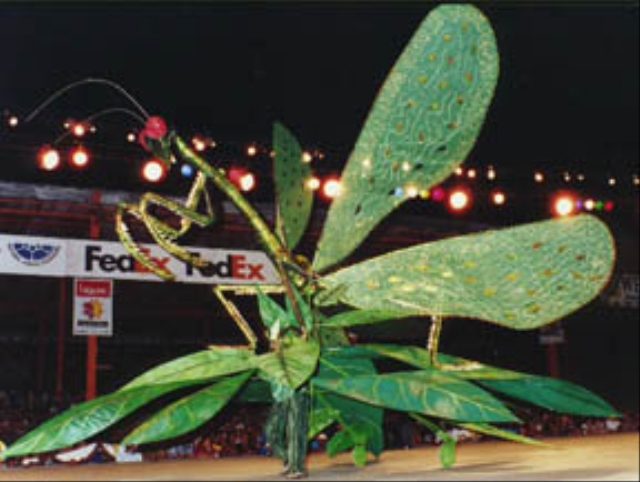Carnival

|
Carnival
What is carnival? Where did the word “carnival” come from? The dynamic economic and political history of the Caribbean is indeed the ingredients of festival arts as we find them today throughout the African and Caribbean Diaspora. Once Columbus had steered his boat through Caribbean waters, it was only a few hundred years before the slave trade was well established. By the early 19th century, some six million slaves had been brought to the Caribbean. Between 1836 and 1917, indentured workers from Europe, west and central Africa, southern China, and India were brought to the Caribbean as labourers.
African influences on carnival traditions Feathers were frequently used by
Africans in their motherland on masks and headdresses as a symbol of our ability
as humans to rise above problems, pains, heartbreaks, illness — to travel to
another world to be reborn and to grow spiritually. Today, we see feathers used
in many, many forms in creating carnival costumes. African dance and music traditions
transformed the early carnival celebrations in the Americas, as African drum
rhythms, large puppets, stick fighters, and stilt dancers began to make their
appearances in the carnival festivities. In many parts of the world, where Catholic Europeans set up colonies and entered into the slave trade, carnival took root. Brazil, once a Portuguese colony, is famous for its carnival, as is Mardi Gras in Louisiana (where African-Americans mixed with French settlers and Native Americans). Carnival celebrations are now found throughout the Caribbean in Barbados, Jamaica, Grenada, Dominica, Haiti, Cuba, St. Thomas, St. Marten; in Central and South America in Belize, Panama, Brazil; and in large cities in Canada and the U.S. where Caribbean people have settled, including Brooklyn, Miami, and Toronto. Even San Francisco has a carnival.
Hummingbird group Carnival in Trinidad and Tobago Like many other nations under colonial
rule, the history of Native Americans and African people in Trinidad is a
brutal, sad story. Spain and England at different times both claimed Trinidad as
their colonies. Under British rule, the French settled in Trinidad, bringing
with them their slaves, customs, and culture. By 1797, 14,000 French settlers
came to live in Trinidad, consisting of about 2,000 whites and 12,000 slaves.
Most of the native peoples (often called the Amerindians) who were the first
people to live in Trinidad, died from forced labour and illness. Carnival was introduced to Trinidad
around 1785, as the French settlers began to arrive. The tradition caught on
quickly, and fancy balls were held where the wealthy planters put on masks,
wigs, and beautiful dresses and danced long into the night. The use of masks had
special meaning for the slaves, because for many African peoples, masking is
widely used in their rituals for the dead. Obviously banned from the masked
balls of the French, the slaves would hold their own little carnivals in their
backyards - using their own rituals and folklore, but also imitating their
masters’ behaviour at the masked balls. For
African people, carnival became a way to express their power as individuals, as
well as their rich cultural traditions. After 1838 (when slavery was abolished),
the freed Africans began to host their own carnival celebrations in the streets
that grew more and more elaborate, and soon became more popular than the balls.
Today, carnival in Trinidad is like a
mirror that reflects the faces the many immigrants who have come to this island
nation from Europe, Africa, India, and China. African, Asian, and American
Indian influences have been particularly strong. Carnival is such an important aspect of life in Trinidad that many schools believe that sponsoring a carnival band is a way to teach young people about their roots and culture. In Trinidad’s Kiddies Carnival, hundreds of schools and community organizations participate in this way, communities work together to develop stronger friendships and greater respect for the many cultures that make up Trinidad.
Caged Canary Creating a carnival production The larger costumes are usually more difficult to design and build. Huge frames are created by bending wire into shapes, then covering with paper mâché, foam, and other materials. Physics play an important role, as the costume must be able to move and dance across stages and streets, and not fall apart! Many different forms of decorations and materials (natural and man-made) are used to transform the costume into a dream of the mind’s eye.
The
Praying Mantis pictured here was created by Ronald
Blaize (from Marabella, Trinidad), who also created All Ah We’s Sun Fire King in
1992. Created primarily from wire, netting, foam, and paint, these awesome
costumes mesmerize and dazzle spectators.
One of the most incredible artists working today in Trinidad is Peter Minshall. He is acclaimed internationally as the foremost artist working in the field of “dancing mobiles,” a form of performance art that combines the three-dimensional quality of large-scale sculpture with the dramatic and choreographic expressiveness of a live human performer. As Minshall has noted, “The dancing mobile is one of many forms to grow out of the masquerade tradition of Trinidad Carnival.”
The route the carnival procession takes. 2010 date 15th February, may just have to slip down for that
ALL IN ALL THE GREATEST CARNIVAL IN THE WORLD |




